What is Piano Tuning
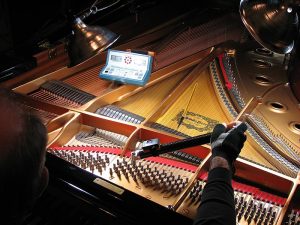 Piano tuning is more than simply adjusting the tension of the piano’s strings. It takes years of practice to develop a refined ear and a good technique to make all 220 strings of a typical piano work together.
Piano tuning is more than simply adjusting the tension of the piano’s strings. It takes years of practice to develop a refined ear and a good technique to make all 220 strings of a typical piano work together.
When in tune, the piano will sound musical. The pianist may not notice as a piano slowly drifts out of tune, but he or she will hear the improvement instantly after a tuning.
How Piano Tuning Is Done
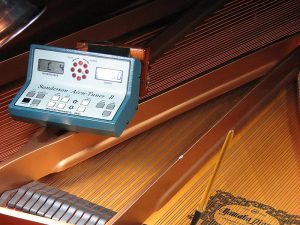
above the strings.
Tuning is the process of coordinating the tension of all the strings so that each string not only produces the correct pitch but also works in harmony with the other strings.
A precision pitch meter is used to detect the pitch of the string being tuned. The pitch meter is programmed with the correct frequency of each note.
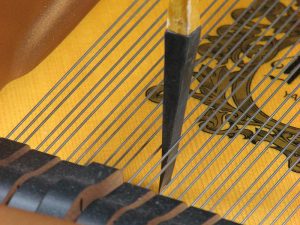
the strings of a unison.
Most notes are composed of multiple strings making up a “unison”. Each string of the unison must be tuned individually. The other strings of the unison must be silenced by inserting a mute.
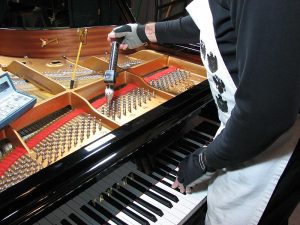
The tension of the string is adjusted by turning a pin with the help of a lever. The hammer is struck several times to “set the string”, which removes the play from the friction points so the pitch won’t drift under the new tension.
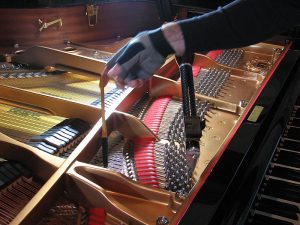
Here’s a tricky part. The other strings belonging to the same note must be set to exactly the same pitch so the strings play in tight unison. This keeps the note clear and pleasant, distinguishing a good tuning from a poor one.
Pitch-Raise
If a piano’s tuning is neglected for too long, not only does its musicality suffer, but the strings will slowly loosen and the piano will fall in pitch and become flat. This will happen whether the piano has been sitting idle or has been played frequently. If this happens, the piano needs a “pitch-raise”.
A piano that is out of tune will not sound very good. A piano in need of a pitch-raise makes matters worse because it will not play properly with other instruments or with vocalists.
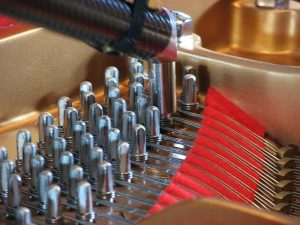
A pitch-raise is an extended tuning that requires more than one tuning pass through the strings. Multiple tuning passes are needed because as the strings are tuned, the combined increase in tension can be several thousand pounds. This will cause the piano to flex. As additional strings are tensioned, the flexing increases and affects the pitch of the strings that were previously tuned. The piano requires a second tuning pass through the strings to get them into tune, and maybe even a third pass in extreme cases.
After the piano is raised to the proper pitch, it will settle a bit and require an additional tuning at a later time to get it to sound as it should. Regular tunings afterward eliminate the need for another pitch-raise in the future.
How Often Should a Piano be Tuned?
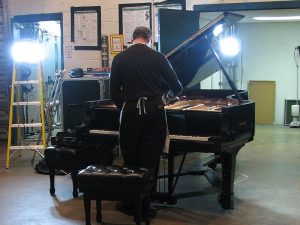
Most manufacturers recommend tuning your piano twice a year. New pianos or pianos that have been newly restrung need more frequent tuning as the new strings stretch. Swings in humidity and, to a lesser extent, in temperature cause a piano to need more frequent tuning. Frequent or hard playing will cause a piano to loose its tune a little more quickly.
As a point of comparison, concert pianos are tuned before every performance, and pianos in busy recording studios may be tuned several times a week! I tune the piano at the Panama City Marina Civic Center monthly as well as before each performance.
For more information about pitch-raising, see the Pitch Raising Technical Bulletin at the Piano Technician’s Guild web site. For tuning, see the Piano Tuning Technical Bulletin.